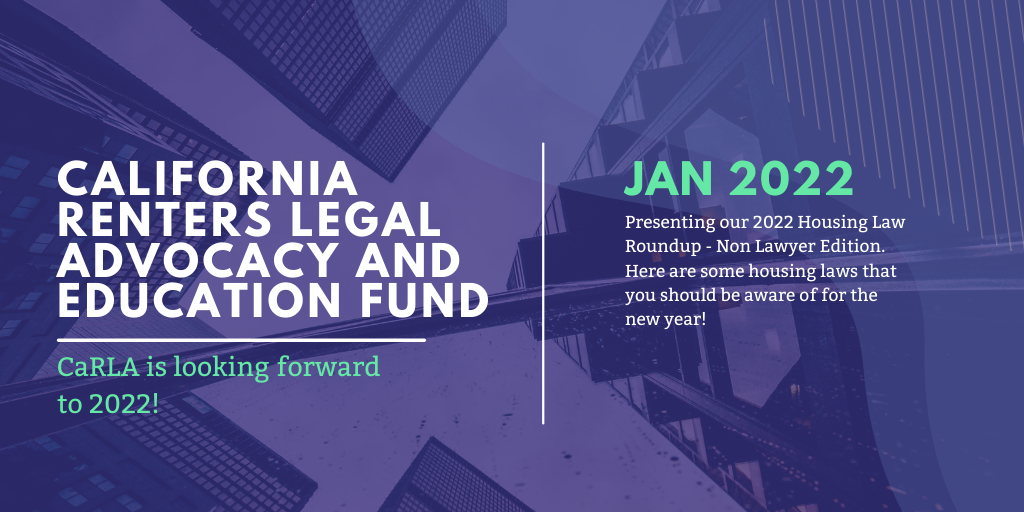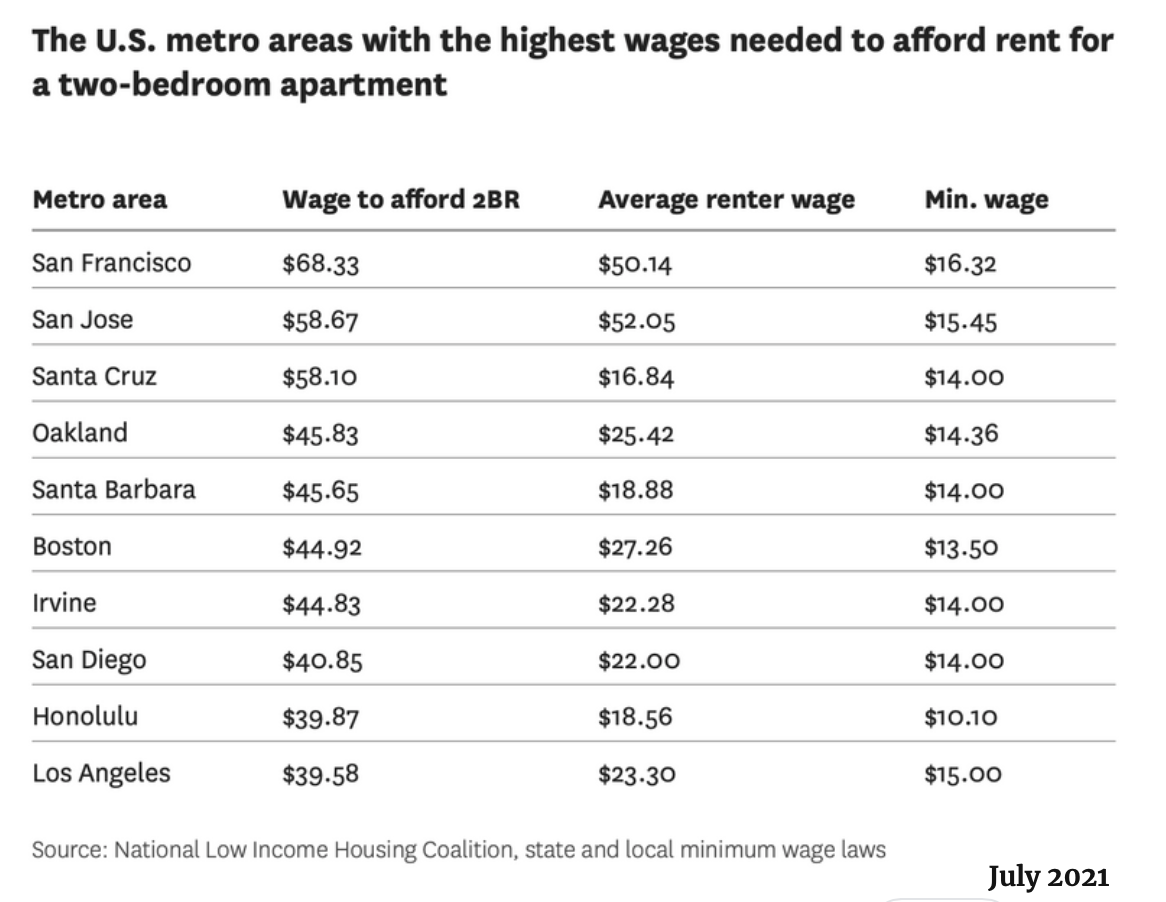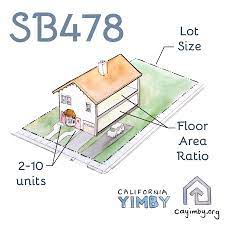
2022 Housing Roundup
Non-Lawyer Edition
by Khang Tran & Greg Magofña
January 2022
Living in California has no doubt exposed you to two things: ridiculous prices and even more ridiculous housing prices. Below is a chart from the National Low Income Housing Coalition from July 2021 to show the needed hourly wage solely to afford rent in the most expensive US metros, not including other necessities such as food and utility bills. Note that eight of 10 of these locations are in California.

While we can’t raise wages to $68.33/hr or fix inflation, the counter to such high housing expenses is simple — build more housing to offset the demand. Easy … right? Wrong. CaRLA wouldn’t exist if it were that easy.
One of the first steps to helping the cause is educate and be aware of all the housing laws around you. Here is a simplified housing law round up for what new housing laws take effect in 2022 – non-lawyer edition.
2022 Housing Laws to Keep an Eye On
(Click on a law to jump to a quick summary)
THE BIG ONES
SB 9 (Sen. Toni Atkins)- Duplexes and Lot Splits a.k.a. “Ending Single-Family Zoning”
Senate Bill 9 or SB9 gives owners of single-family zoned property the ability to split their lots into two parcels and develop a duplex on each. This allows people to build more housing for more people in a state in which nearly two-thirds of all the residences in California are single-family homes. And as much as three-quarters of the developable land in the state is now zoned only for single-family housing, according to UC Berkeley research as reported by the LA Times.
Sounds simple right? We wish. Though this bill has been dubbed the end of single-family zoning, there are many restrictions and exclusions built into the law. We’ll try to simplify here, but you’ll probably need to read the fine print, or wait for CaRLA’s forthcoming guide to single-family home redevelopment.
- The owner of an SB9 property has to sign an affidavit saying that one of the homes will be their primary residence and will be owner-occupied for at least three years.
- SB9 only applies to US Census urban areas only and excludes certain land use designations, such as historic districts, earthquake fault zones and very high fire hazard severity zones.
- Resulting parcels must be a minimum of 1200 sq. feet with at least one parking space per unit.
- An SB9 development can’t require the domlition of any rent-controlled units and or units that have been occupied by a tenant in the past three years.
- Lastly, and most significantly, SB9 gives local governments free rein to impose local development standards as long as those standards would not “physically preclude” a duplex. Many local governments have already taken this allowance to enact excessive local standards that would make developing under the law financially infeasible.
Many people call this the end of single-family zoning, however, with the restrictions in place such as the requirement to live in it for three years, it would not change the landscape of neighborhoods by a lot. According to the UC Berkeley Terner Center, with SB9’s introduction, an estimated 700,00 additional units would be eligible to become housing units, creating a 40% increase in California’s housing development potential in single-family zones. This however does not mean they will be built. Research and data from the Public Policy Institute of California and the CA Legislative Analyst’s Office shows that there was a home building shortage of 3.5 million homes from 1980 to 2021.
We think this is an effective start to increasing the supply of housing in California at an affordable cost, but if we really want to make a dent in the housing crisis and open up exclusive suburbs, we need to go farther in the future.
SB 10 (Sen. Atkins, Caballero, Rivas, Wiener) – Planning and zoning: Housing development: density
SB 10 eases restrictions for cities that wish to create more dense affordable housing for their people. This is an opt-in law that makes it easier to create zoning changes for projects of up to 10 units in transit rich or urban infill areas that provide deed-restricted affordable housing onsite. These projects would then be exempt from CEQA. Adoption of SB 10 would require a 2/3 vote of a city council. Parcels subject to SB 10 would not be allowed to be down zoned in the future.
This is another good bill for California, pushing for further approvals for more housing, but we have to remember, this is an opt-in law and won’t make a difference in cities with anti-housing majority councils.
PRIZE WINNERS
SB 290 (Sen. Nancy Skinner) – State Density Bonus Law (SDBL)
SB 290 once again amends provisions to the State Density Bonus Law, enhancing the additions to SB 1227 back in 2018. With these additions to the original density bonus law passed in 1979, which grants developers additional housing units and concessions on things like parking in exchange for the inclusion of low-income housing onsite, the goal of this law is to provide further incentives for housing developers if they include affordable units for students and moderate-income Californians. The main goal of SB 290 is to ultimately alleviate college student housing as many are suffering from homelessness.
Today one in five college students are unsheltered, living in cars or at school throughout the Bay Area. The SDBL has been an effective tool to build much needed mixed-income developments across the state and we applaud Senator Skinner’s continued leadership on trying to get ahead of the ball at addressing our compounding housing crisis.
SB 478 (Sen. Scott Wiener) – Minimum Floor Area Ratio (FAR)/Lot Coverage Standards and Prohibition on CC&R Restrictions of FAR for Missing Middle Multifamily Housing
SB 478’s purpose is to stop the misuse of floor area ratio (FAR) and minimum lot size requirement as an excuse to prevent construction of housing in areas that would allow for them. Previously agencies would impose a FAR of less than one to prevent housing being built. SB 478 creates a 1.5 FAR standard ratio, ensuring that housing can actually be built in areas that are zoned for it.
As explained by our friends at CA YIMBY:
“Floor area ratio restrictions control how large a building can be, based on the size of the parcel of land. Many cities misuse this restriction to prevent multifamily housing: for instance city of Del Mar restricts floor area ratio to .35—meaning the building’s total floor space can take up only 35% of the total lot size. For example, a 2000 square foot lot would only be allowed to have a duplex that is 700 square feet total—350 square feet per home.”

(Diagram from CA Yimby)
FAR can be a little confusing, even for trained planners like Greg, but this little change goes a long way to prevent cities from using underhanded ways to say they’re zoned for certain kinds of housing but make it technically impossible to build.
SB 8 (Anna Caballero, Nancy Skinner) – Extension of Housing Crisis Act to 2030
SB 8 extends the groundbreaking law of Housing Crisis Act to 2030 and clarifies what projects are protected under the law; the rules around replacing low income housing, Section 8, and others with units that support elderly and unsheltered people; and makes clear that developers cannot demolish multiple units and turn them into single family homes.
With the pandemic affecting the way we live, SB 8 gives California more time to recover while meeting housing productions. The clarified guidelines further protect low-income families from being driven out of their homes.
SLEEPER CELLS
AB1174 (Assembly Member Grayson) – Planning and zoning
AB 1174 amends SB 35, which was designed to help cities provide the zoning and streamlining approvals for housing, now required by state law. AB 1174 enacts mostly technical changes to get more housing developmental projects approved.
The Bay Area Council describes the law as follows:
“AB 1174 fixes a loophole in SB 35 (Weiner), which was passed in 2017 and allows for fast-track approval of housing developments that meet various state and local requirements. SB 35 included a provision that unless construction begins within three years the project must return to square one for approval. But the three-year time limit in SB 35 didn’t account for delays caused by frivolous lawsuits filed against projects by housing opponents, among others. Allowing such delays and the huge costs that come with them can often be a death knell for new housing projects. The new law includes a number of other important administrative provisions.”
AB 602 (Assembly Member Grayson) – Impact Fee Nexus Study Standards and Procedures
AB 602 focuses on reforming how cities collect impact fees so that smaller units are not unfairly punished with unnecessary high cost by tying impact fees to nexus studies and applying them by their impact by square footage rather than by unit count. Jurisdictions would also be required to publish their impact fee scheduled online.
You know how when you’re about to pay for a car and then they tell you about the ten different fees that you have to pay, jacking up the price from $10,000 all the way to nearly $20,000? Yeah, same with housing. Impact fees can add up to over $100,000 to the cost of single apartment homes for new housing in a way that smaller units are not unfairly punished with high costs. In most cases, the large amount of unspecified fees can halt housing development altogether due to the cost outweighing what renters and home buyers can afford.
AB 571 (Assembly Member Chad Mayes) – Prohibition of Affordable Housing Fees on Affordable Housing Units
This bill functions similarly to AB602 but outrights prohibits any impact fees on affordable housing units that are part of the State Density Bonus Law project.
Another win for California housing. With fees being prohibited, it significantly lowers the cost of housing development allowing people to be able to afford the cost of rent.
SB 7 (Sen. Atkins) – Streamlined Environmental Leadership Development Project Litigation Process
SB 7 provides streamlining for qualifying to shorten the environmental review (CEQA) process. . This also shortens the process of CEQA lawsuits from three years to less than a year. In addition, it expands ELDP eligibility to include qualifying mixed-use and residential projects previously not eligible.
AB 1584 (Committee on Housing) – Covenants that Limit an ADU on Single-Family Lot Rendered Unenforceable
This bill helps aid the construction of ADU’s for homes. Any restriction in contract, deed, or other instrument would be voided if it unreasonably restricts or prohibits construction of an ADU. Homeowners associations enforce conditions on properties through these covenants, and they can be a major barrier to ADU development where they apply.
Yet another win for California housing.
CaRLA believes that progress has been made but can still go further and faster. SB 9 and 10 being the biggest changes, with the flexibility of lots splits in combinations ADU’s and duplexes along with SB 10 allowing further flexibility for agencies to build housing near transit areas.
With many other supporting bills being passed or amended to help combat California’s housing crisis, 2022 will hopefully be a year of plentiful housing developments.
